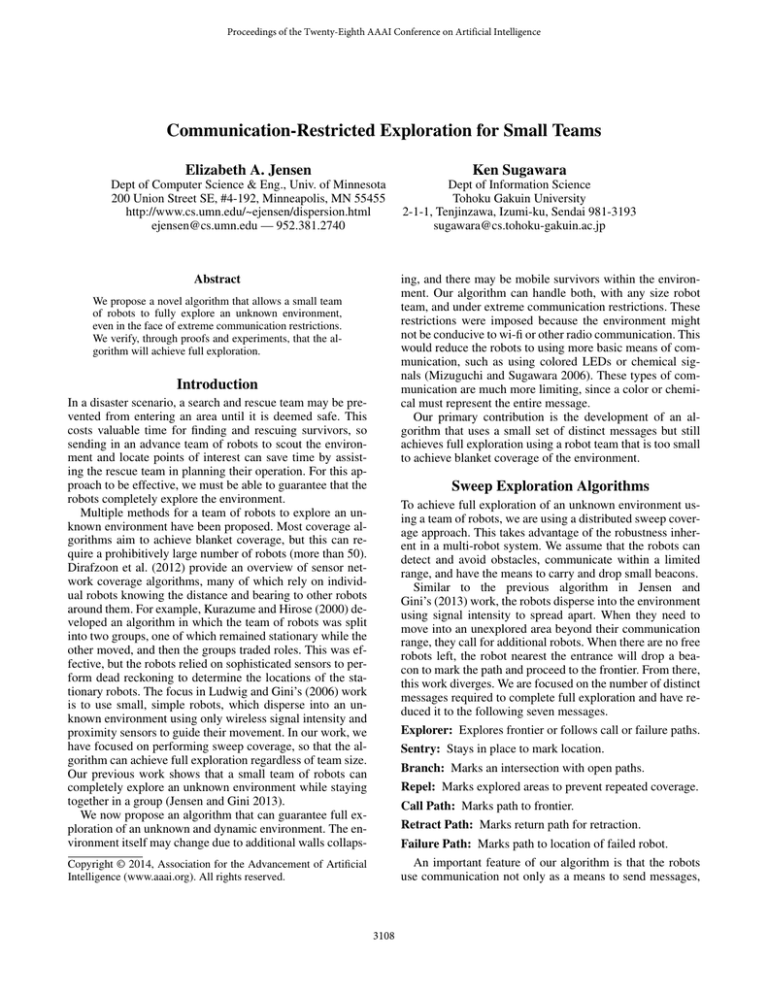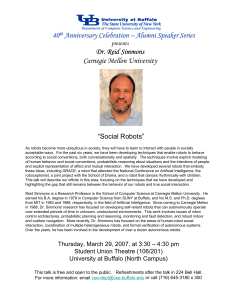
Proceedings of the Twenty-Eighth AAAI Conference on Artificial Intelligence
Communication-Restricted Exploration for Small Teams
Elizabeth A. Jensen
Ken Sugawara
Dept of Computer Science & Eng., Univ. of Minnesota
200 Union Street SE, #4-192, Minneapolis, MN 55455
http://www.cs.umn.edu/~ejensen/dispersion.html
ejensen@cs.umn.edu — 952.381.2740
Dept of Information Science
Tohoku Gakuin University
2-1-1, Tenjinzawa, Izumi-ku, Sendai 981-3193
sugawara@cs.tohoku-gakuin.ac.jp
Abstract
ing, and there may be mobile survivors within the environment. Our algorithm can handle both, with any size robot
team, and under extreme communication restrictions. These
restrictions were imposed because the environment might
not be conducive to wi-fi or other radio communication. This
would reduce the robots to using more basic means of communication, such as using colored LEDs or chemical signals (Mizuguchi and Sugawara 2006). These types of communication are much more limiting, since a color or chemical must represent the entire message.
Our primary contribution is the development of an algorithm that uses a small set of distinct messages but still
achieves full exploration using a robot team that is too small
to achieve blanket coverage of the environment.
We propose a novel algorithm that allows a small team
of robots to fully explore an unknown environment,
even in the face of extreme communication restrictions.
We verify, through proofs and experiments, that the algorithm will achieve full exploration.
Introduction
In a disaster scenario, a search and rescue team may be prevented from entering an area until it is deemed safe. This
costs valuable time for finding and rescuing survivors, so
sending in an advance team of robots to scout the environment and locate points of interest can save time by assisting the rescue team in planning their operation. For this approach to be effective, we must be able to guarantee that the
robots completely explore the environment.
Multiple methods for a team of robots to explore an unknown environment have been proposed. Most coverage algorithms aim to achieve blanket coverage, but this can require a prohibitively large number of robots (more than 50).
Dirafzoon et al. (2012) provide an overview of sensor network coverage algorithms, many of which rely on individual robots knowing the distance and bearing to other robots
around them. For example, Kurazume and Hirose (2000) developed an algorithm in which the team of robots was split
into two groups, one of which remained stationary while the
other moved, and then the groups traded roles. This was effective, but the robots relied on sophisticated sensors to perform dead reckoning to determine the locations of the stationary robots. The focus in Ludwig and Gini’s (2006) work
is to use small, simple robots, which disperse into an unknown environment using only wireless signal intensity and
proximity sensors to guide their movement. In our work, we
have focused on performing sweep coverage, so that the algorithm can achieve full exploration regardless of team size.
Our previous work shows that a small team of robots can
completely explore an unknown environment while staying
together in a group (Jensen and Gini 2013).
We now propose an algorithm that can guarantee full exploration of an unknown and dynamic environment. The environment itself may change due to additional walls collaps-
Sweep Exploration Algorithms
To achieve full exploration of an unknown environment using a team of robots, we are using a distributed sweep coverage approach. This takes advantage of the robustness inherent in a multi-robot system. We assume that the robots can
detect and avoid obstacles, communicate within a limited
range, and have the means to carry and drop small beacons.
Similar to the previous algorithm in Jensen and
Gini’s (2013) work, the robots disperse into the environment
using signal intensity to spread apart. When they need to
move into an unexplored area beyond their communication
range, they call for additional robots. When there are no free
robots left, the robot nearest the entrance will drop a beacon to mark the path and proceed to the frontier. From there,
this work diverges. We are focused on the number of distinct
messages required to complete full exploration and have reduced it to the following seven messages.
Explorer: Explores frontier or follows call or failure paths.
Sentry: Stays in place to mark location.
Branch: Marks an intersection with open paths.
Repel: Marks explored areas to prevent repeated coverage.
Call Path: Marks path to frontier.
Retract Path: Marks return path for retraction.
Failure Path: Marks path to location of failed robot.
An important feature of our algorithm is that the robots
use communication not only as a means to send messages,
Copyright © 2014, Association for the Advancement of Artificial
Intelligence (www.aaai.org). All rights reserved.
3108
Figure 2: Different stages in the exploration of a corridor.
Robots are identified by R#, beacons by B#, and each message by its initials.
the four repel beacons. In a more complex environment, with
larger open areas and multiple rooms, the robots drop more
beacons to mark paths and explored areas.
Figure 1: Experimental setup of three robots on the screen
with an open environment with only exterior walls.
Conclusions and Future Work
Our main contribution is a distributed algorithm for robot
team exploration of unknown environments with extremely
limited communication. Our algorithm uses the communication signal intensity to help guide the exploration, and
we show that this method is viable with multiple types of
communication, including highly restricted forms, such as
chemical signals. In the supplementary materials we provide
proofs that guarantee full coverage and that the seven messages detailed above are the minimum required.
As future work, we plan to incorporate a means of communicating directly with humans in real-time during the exploration to help a mobile survivor find a safe path to an
exit or to allow the rescuers to request additional information about a specific location. We also plan to include human input during the exploration to test the algorithm under
several levels of autonomy.
Acknowledgment: Research partially funded by the NSF’s
2013 East Asia and Pacific Summer Institute, and the Japan
Society for the Promotion of Science’s Summer Program.
but also as a means to direct their movements. This helps to
ensure that the robots stay within range of each other, so that
the group stays together to complete the exploration. In addition the algorithm is not dependent on any specific communication method to function, making it versatile and usable
on multiple types of robots in many different environments.
Experimental Setup
Our experiments were conducted using modified e-puck
robots on a LED flat screen TV laid flat (shown in Figure 1), with a camera above to track the robots’ locations.
Because we were using an LED screen, we had only three
distinct colors we could use to simulate the chemical signals. However, the screen also gave us a benefit, in that we
could overlap different colors, and the robots would still detect the individual colors, not the combination. We added IR
sensors with color filters for the robots to detect the signals
displayed below them on the screen, and IR LEDs on top of
the robots for tracking their locations.
With only three colors to work with, we also had to use sequences of colors to communicate the messages. In Figure 2
we show how three robots explored a simple corridor. The
figure uses five colors because sequences cannot easily be
shown in a still image, and, similarly, we do not show every
change of state. In the left column of the example we show
the initial dispersion of the three robots. Robot R1 set up as a
sentry and immediately called for another robot to continue
the exploration, which R2 did. When R2 requested another
robot, R3 moved past both R1 and R2, which switched back
to sentries after being passed. When R3 calls, the message
passes through R2, and it is R1 that responds because there
are no more free robots, and beacon B1 is left as a sentry at
the entrance. At the top of the right column, R1 detects it is
in a dead-end, and signals a retraction. It drops B2 to repel
further exploration, and then returns to the entrance along
the retract path and leaves the corridor entirely. Each robot
follows this pattern until all have exited, leaving behind only
References
A. Dirafzoon, S. Emrani, S. M. Amin Salehizadeh, and
M. B. Menhaj. Coverage control in unknown environments
using neural networks. Artificial Intelligence Review, pages
237–255, 2012.
E. A. Jensen and M. Gini. Rolling dispersion for robot
teams. In Proc. Int’l Joint Conf. on Artificial Intelligence,
pages 2473–2479, 2013.
R. Kurazume and S. Hirose. An experimental study of a
cooperative positioning system. Autonomous Robots, pages
43–52, 2000.
L. Ludwig and M. Gini. Robotic swarm dispersion using wireless intensity signals. In Distributed Autonomous
Robotic Systems 7, pages 135–144, 2006.
T. Mizuguchi and K. Sugawara. Proportion regulation in
task allocation systems. IEICE Trans. Fundamentals, E89A(10):2745–2751, 2006.
3109



